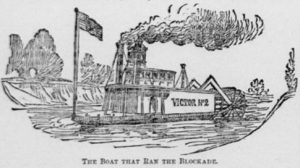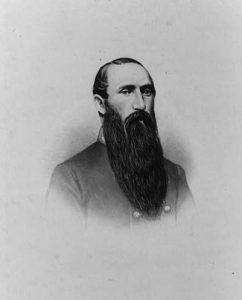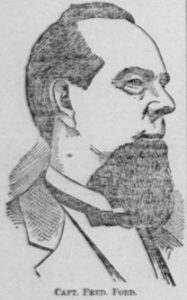A Perilous Voyage on the Kanawha: Jenkins Attacks the Victor No. 2

Riverine warfare has perhaps received less attention in Civil War historiography when compared to other naval or land theaters. Rivers played a critical role in moving and supplying armies in the field, and offered avenues of invasion or retreat. The Federal government relied heavily on privately-owned steamers to move troops and supplies, and with them the keen knowledge of veteran pilots who plied their local tributaries. These boats often operated without the benefit of armament or the protection of gunboats, and were frequently subject to attack from water and land. One such attack on the steamer Victor No. 2 garnered widespread attention during and after the war.
The sternwheel steam packet Victor No. 2 was laid in Cincinnati and launched in July 1860, navigating the Ohio River between Pomeroy and Portsmouth three times each week. The boat was described as “neatly built and handsomely finished,” boasting thirteen state-rooms and accommodations for thirty passengers. At less than 100 tons and a light draft, observers noted that Victor No. 2 “will be as fast a steamer as floats on the Ohio.”[1] Following the outbreak of the Civil War, Victor No. 2 was transferred to the Kanawha River, and under Federal contract carried troops and supplies between the mouth of the Kanawha at Point Pleasant as far south as Kanawha Falls (near Gauley Bridge). The boat came under fire several times in the fall of 1861, but no attempt was more desperate than the attack of March 29, 1863.

On March 18, 1863, General Albert Gallatin Jenkins and two battalions of Confederate cavalry (portions of the 8th and 16th Virginia cavalries) departed Dublin, Virginia, bound for the Kanawha Valley. Many of these men were natives of western Virginia, and Jenkins had his eye on fresh horses and supplies, especially at the lightly guarded government storehouses at Point Pleasant. Jenkins had raided through the area the previous autumn in conjunction with General W.W. Loring’s advance down the Kanawha Valley, and he now hoped to hit these storehouses to refit his command ahead of the summer campaign.

Jenkins moved quickly, facing little opposition until reaching Hurricane Bridge, west of Charleston. Here, on March 28, a small Union garrison declined Jenkins’ calls for surrender. After several hours of skirmishing, Jenkins bypassed the garrison, continuing north and west towards his goal at Point Pleasant. His command followed Hurricane Creek to the Kanawha River, arriving just south of present-day Frazier’s Bottom. While most of the Kanawha fleet was lying above Charleston, Jenkins was apprised of two boats steaming down the river. With the river narrowing and turning sharply just below Frazier’s Bottom, Jenkins hatched a plan to capture one or both of the steamboats to float his command down the Kanawha to Point Pleasant.
This was not the first time Jenkins had sprung a trap for a steamboat. On July 11, 1861, Jenkins concealed his men along the bank of the Ohio River near his home at Green Bottom, and hailed the approaching Fannie McBurnie. When the steamer approached the bank, Jenkins unleashed his men and boarded the boat, capturing a cache of swords and revolvers. He may have been unaware that Victor No. 2 held a more significant bounty onboard.

Steaming down the Kanawha was Victor No. 2, under the command of Captain Fred Ford. An accomplished pilot, Ford had cut his teeth running routes on the Ohio and Cumberland rivers, and following the outbreak of the Civil War assumed command of the steamer Marmora, before later being appointed Master of Victor No. 2. On March 29, 1863, Ford was carrying a crew of one dozen men, some 15 or 20 sick and wounded soldiers headed to the post hospital at Gallipolis, Ohio, and two families, including women and children. The deck was further crowded with 18 or 20 disabled cavalry and artillery horses bound for a convalescent camp. Ford’s most important passenger was army Paymaster Benjamin Rush Cowen, carrying $175,000 of government funds on board. Following Victor No. 2 was the steamer General Meigs, under the command of Captain James H. Summers.
Jenkins deployed his men on either side of the Kanawha River, extending a mile downriver, with the men concealing in houses and behind trees and barricades along the riverbank. As Victor No. 2 rounded a bend in the river, Ford spied the Confederate troops lining the riverbanks below him. “There was no time for consultation,” recalled Ford, who believed “the importance of getting through, if possible, in order that we might, by a swift passage to Point Pleasant and Gallipolis, warn those places of the impending danger and perhaps be in time to save them from falling into the hands of the enemy.”[2] Ford ordered the furnaces stoked to a full head of steam, intending to run Jenkins’ blockade with the valves wide open. He ordered the families to take cover, and that any soldiers with arms should use them in defense of his boat. Ford took his position in the pilot house and instructed the pilot “we would under no circumstances surrender; that he must stand to the wheel, and if he was killed I would take the wheel myself.”[3]
As Victor No. 2 neared Jenkins’ gauntlet, his men called from the riverbank for the boat to surrender. Several of Jenkins’ men recognized Ford, who recalled that the Confederates “called me by name, shouting repeatedly that if I did not surrender they would kill me.”[4] Ford declined, and the Confederates opened fire on the boat. “The bullets flew around us like hail,” Ford recalled, the scene presenting “the wildest alarm and confusion…the groans of the wounded, the screams of the terrified women and children, and the cries of the plunging animals filled the air, mingling with the constant whistling of bullets.”[5]
Jenkins’ men trained their shots on the pilothouse and steampipe. One ball hit the engineer’s bell, causing the confused engineer to briefly cut steam. Another bullet struck the wheel and wounded the pilot’s hand, while another shot hit home, penetrating the steampipe and slowing the boat. It took the damaged Victor No. 2 eight or nine harrowing minutes to limp through the length of Jenkins’ blockade.

After mounted Confederates gave up the chase, Ford stopped the boat to patch the steampipe and count his losses. One crew member and one soldier were killed in the attack, and another dozen men wounded. At least five of the horses on deck were killed, and nearly all others had been wounded. “The blood of men and animals was flowing freely over the deck, presenting a ghastly spectacle,” recalled Ford.[6] The General Meigs was likewise heavily riddled but sustained no casualties. The Gallipolis Journal counted 200 bullet holes in each vessel, while another paper could find “scarcely a space of six feet on either boat that has not a bullet hole through it.”[7]
After repairing the steampipe, the boats traveled four hours further to Point Pleasant, where the Federal garrison was apprised of Jenkins’ advance. Jenkins arrived at Point Pleasant the following day to find the federal garrison fortified inside the courthouse. After several hours of sustained skirmishing, Jenkins withdrew his command from the town. While the Confederates did manage to set fire to some of the commissary buildings, they failed to carry away any great number of supplies. Victor No. 2 carried three howitzers and one company of troops from nearby Gallipolis, helping to bolster the Federal garrison, and then carried to safety a barge filled with government supplies that had been precariously docked at Point Pleasant. Following the battle, the boat carried Confederate prisoners across the river to confinement in Ohio.
After being turned back at Point Pleasant Jenkins turned his command south and was soon called east by Robert E. Lee to join the Army of Northern Virginia. In less than three months he was screening the Confederate advance into Pennsylvania, far from the backwaters of West Virginia. While Jenkins’ days of ambushing steamboats were over, this particular stretch of the Kanawha River remained a favorite spot of Confederates and guerillas. Less than a year later in February 1864 Brigadier General Eliakim P. Scammon was captured aboard the steamboat B.C. Levi at nearby Red House Shoals.

Praise was heaped on Captain Ford and the crew of Victor No. 2, paymaster Cowen noting that “I have not the slightest hesitation in saying that to the determined courage of Capt. Ford on the occasion, the Government is indebted for the preservation of the Government property in my hands. The slightest hesitancy on his part would doubtless have resulted in our capture, which to the command supplied by the Kanawha boats would have been disastrous.” [8] Calls were made for Ford to be placed in command of the Kanawha fleet and following the war Paymaster Cowen spearheaded an effort to secure a pension for Ford, though it is not clear whether that effort was successful. Ford died in 1910 and is buried in Parkersburg, West Virginia.
[1] Pomeroy Weekly Telegraph – July 03, 1860.
[2] National Tribune – June 03, 1886
[3] ibid
[4] ibid
[5] ibid
[6] ibid
[7] Daily Ohio Statesman, April 04, 1863
[8] ibid
Interesting account.
Love the scenic stretches of the Kanawha around Gauley; used to drive on old US 60 through the state from the Shenandoah Valley to visit my (ex) girlfriend at college in Kentucky. Account reminds me a little of Bedford Forrest’s spectacular shelling of Union river traffic and naval units at Johnsonville in 1864.
Great post. You should do a follow up on the capture of Scammon that you mention. That’s a great untold story.